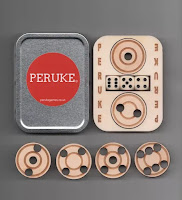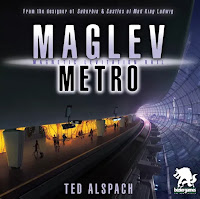Game: Peruke
Publisher: Peruke Games
Designer: Mark Littlewood
Year: 2019
Peruke is a self-published game, which can be purchased in the UK from the designer's
website. It plays 2-4 players and features lovely chunky wooden pieces in a very simple game of dice rolling and push your luck.
Peruke is a very portable game, neatly packed into a small tin. We've played it outdoors, on the sofa, using the foot stool as a table, and I'm sure it would be right at home in a trendy bar setting.
Gameplay
At the start of a game of
Peruke each player will take a row of wooden tokens numbered from one to six. In the case of a two-player game you will take two rows or tokens. After a quick set-up roll so that some of your tokens start defended, players will then take turns rolling the three dice. You can use the results of your dice to attack or defend. If you defend then you flip a token matching the number rolled on a die over to make it harder to take. If you attack then you either take a face up token from an opponent of your choice, or flip one of their face down tokens to be face up. You repeat this process for all three of your dice, meaning that a roll of a double may let you take even a defended piece from an opponent.
The game will end when one player has run out of tokens in their row. At which point all players will score the value of each of the tokens they took, plus the value of any tokens remaining in front of them.
Amy’s Final Thoughts
Luck and Strategy are two of the biggest components of board games. Some games are high strategy, no luck, like Chess, which certainly has it;'s place but can be a 'marmite' game. Some games are high strategy, high luck, like wargames, where having the right unit in the right place should do wonders, but occasionally, every now and then, the dice decide that a peasant will win the fight against a dragon.Very rarely you encounter no strategy, high luck games, Snakes and Ladders being the perfect example, and, well there's a reason that adults don't enjoy that game. Unfortunately while Peruke isn't quite Snakes and Ladders level of no strategy, it's not far off. You roll the dice then make a very basic choice. Moreover, this choice becomes further and further limited as the game goes on. When your opponent only has a three left and you only have a two left it's a race to see who can roll their opponents number more often than they can roll it themselves. Hardly a battle of the brains.
While it may be lacking in substance, Peruke certainly gets some style points. The moment you open the tin you are greeted by tasteful, chunky, wooden tokens. Even the way they are stored in the tin is surprisingly satisfying. I'm also willing to confess that the gameplay is likely to be better with more players, as then you have the option to bully one player out of the game early in order to score your high value tokens still in front of you, this in turn makes you more inclined to play defensively so you aren't the target of the bullying. If you are looking for a simply, but pretty looking filler game for 3-4 players then you probably will get some entertainment out of Peruke.
Overall
Peruke feels like a 'gift shop' game, the kind of thing that someone might buy for you for secret santa, because they know you like games, and this one looked pretty. It does have some value as a filler game, though I strongly advise against playing the two player variant, which only manages to further dilute the slim number of choices you will be making over the course of the game.
Fi’s Final Thoughts
Peruke really lacks any real decision making at all, it's the least thinking I've done while playing a game for a long, long time. You are completely at the mercy of the dice and simply choosing whether to attack or defend on each turn, if you're presented with a choice at all. In the latter stages of the game, you might even roll the dice and do nothing at all.
The two player game seems to make choices even more obvious, with the choice of keeping your own back row of pieces seeming to be doubly as powerful as attacking and/or defending elsewhere. Very rarely are you presented with a choice that is not obvious and even when you're forced to think it'll either be good luck or bad luck that will win or lose you the game over the course of many pointless rolls of the dice.
The most fun I had with
Peruke was the task of trying to get the parts back into the tin - it's really well designed packaging that fits the pieces very snuggly, plus it ends up displaying the game really well too. Peruke has a lovely hand crafted look and when you open the tin, it looks really enticing. Unfortunately, I'd be surprised if most people are not disappointed by lack of fun inside the tin.
You Might Like...- The presentation of Peruke is lovely.
- Peruke might make an OK activity to play at the bar.
You Might Not Like...- This is 'roll dice and hope you like what you roll' the game.
- 80% of moves are obvious and the remaining 20% require very little thought.
The Verdict 3/10 Peruke is presented really nicely and looks like the sort of gift you might buy at a craft market. Sadly there is very little game in the box and it seems unlikely that it would be the kind of gift that might get a friend interested in the hobby. Roll some dice, make very few decisions and whoever rolled the best will win...
Peruke was kindly provided as review copy by Peruke Games.

























:strip_icc()/pic5854467.jpg)



